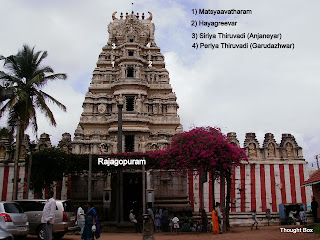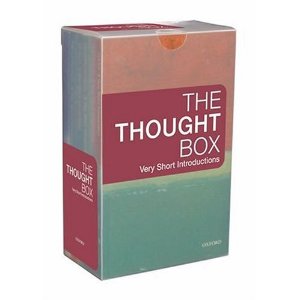 |
| Rajagopuram |
Srimathe Aravindavalli nayika samedha Sri Aprameya Parabrhammane Namaha
In Doddamallur there are three temples to be visited. 1) Sri Aprameya Perumal/Navaneetha Krishnan temple. 2) Sri Ramar temple and 3) Sri Nadhi Narasimhar temple. Seeking the blessings of these deities, I am recording here, my observations and appreciation of our forefathers’ efforts in propagating our religion. It is also my desire to pass on to those who may visit these temples, the pleasure I got in my visit.
There are very few temples, which date back not in years, but in yugas. Sri Aprameya perumal temple in Doddamallur is one such temple. In fact, one could go to the extent that this temple is beyond period. Thinking about period, I am compelled to say a few words about period/time.
Our celestial calendar or the Hindu Cosmological Time Cycle measures time in relation to the life of the creator Brahma. Citing Vishnu Purana or Surya Sidhdhantha (Chapter1 Sloka 11 to 23), one day (i.e. sunrise to sunset) for Brahma is one Kalpa. There are thirty kalpas, one for each day of Brahma. Kalpa consists of fourteen Manvantharam, each Manvantharam consisting of 71 Mahayuga, each Mahayuga consisting of four yugams (Kritha-17,28,000 solar years,Thretha-12,96,000 solar years, Dwapara-8,64,000 solar years and Kali yuga-4,32,000 solar years) One Mahayuga is equivalent to 43,20,000 solar years..1000 such Mahyuga is a day for Brahma. His life of 100 years is divided into two Paraardhas. He has completed 50 years and is on the first day of 51st year. We are living in His Dwidheeya Paraardha (2nd half) in Swetha Varaha Kalpam (first kalpa), Vaivaswatha Manvantharam (7th manvanthara) and first
Our celestial calendar or the Hindu Cosmological Time Cycle measures time in relation to the life of the creator Brahma. Citing Vishnu Purana or Surya Sidhdhantha (Chapter1 Sloka 11 to 23), one day (i.e. sunrise to sunset) for Brahma is one Kalpa. There are thirty kalpas, one for each day of Brahma. Kalpa consists of fourteen Manvantharam, each Manvantharam consisting of 71 Mahayuga, each Mahayuga consisting of four yugams (Kritha-17,28,000 solar years,Thretha-12,96,000 solar years, Dwapara-8,64,000 solar years and Kali yuga-4,32,000 solar years) One Mahayuga is equivalent to 43,20,000 solar years..1000 such Mahyuga is a day for Brahma. His life of 100 years is divided into two Paraardhas. He has completed 50 years and is on the first day of 51st year. We are living in His Dwidheeya Paraardha (2nd half) in Swetha Varaha Kalpam (first kalpa), Vaivaswatha Manvantharam (7th manvanthara) and first
 |
| North Madal |
In our conventional Hindu calendar, we use a sixty year cycle, called Samvatsaram. We are in Khara (25th) year. To put all this in a simplified manner, one may recollect our sankalpam during puja.
“Dwidheeya Paraardhe, Sri Swetha Varaha Kalpe, Vaivaswatha Manvanthare, Kaliyuge, Prathame
 |
| South Madal |
paadhe--- khara naama samvathsare, followed by ayana (2), rhuthu (6), vasaram (7) and nakshathram (27)".
I Sri Apprameya Perumal Temple.
Puranik records mention that the Aprmeyar vigraham was installed by Vyasa Maharishi and,Rishi kapila (some say Raja Vijayapalan), worshipped this deity in Krithayugam.Kanva Mahirishi worshipped in Threthayugam,Rishi Lambhashrava worshipped in Dwaparayugam and worshipped in Kaliyugam.
 |
| Northface Gopuram |
 |
| Rajagopuram |
 |
Coming round in the inner praakaaram, we worship Sri Andal and the other11 Azhwars. Next there is a sannithi for Ramanujar, Koorathazhwar, Vedantha Desikar, Pillai Lokacharya and Manavala Mamuni.
 Going round, we come to the sannithi of Navaneeta Krishnan, locally known as Ambegalu Krishna. He is so dark and beautiful. Bedecked in jewellary like chain, araignnan (on the hip) thodu, thandai, Golusu and what not! The chain with Puli Nagam is supposed to be to prevent dhrishti. He is crawling towards you, with his right hand raised and holding a lump of navaneetham. You get an urge to lift him and hug him. (approx. 140 years ago the then Mysore Maharaja did it. But he took Him to his palace and for that suffered a punishment.) That’s a legend.
Going round, we come to the sannithi of Navaneeta Krishnan, locally known as Ambegalu Krishna. He is so dark and beautiful. Bedecked in jewellary like chain, araignnan (on the hip) thodu, thandai, Golusu and what not! The chain with Puli Nagam is supposed to be to prevent dhrishti. He is crawling towards you, with his right hand raised and holding a lump of navaneetham. You get an urge to lift him and hug him. (approx. 140 years ago the then Mysore Maharaja did it. But he took Him to his palace and for that suffered a punishment.) That’s a legend.II Sri Ramar Temple
On the aghraharam road facing the Apprameya/Krishna temple, about 100 meters away Ramar Temple is located. As you enter, there is a big mandapam. Facing this mandapam are three sannithis. The center is of Sri Rama. Rama and Seetha Devi are sitting. Lakshmanan with folded hands is standing left side of Seetha Devi Anjaneya is sitting at the feet of Rama. On the right side of Ramar sannithi, is Sri Lakshmi Narasimhar Sannithi. Sri Lakshmi Narasimhar vigraham is two sided. In the front side, SriLakshmi Narasimhar and in the back Sri Sudarsanar. One the left side of Ramar Sannithi is Sri Venugopalan. Unlike in other places, He is standing with four arms, two upper arms holding Sangam, Chakram and in the other two, his venu.
III Sri Nadhi Narasimhar
After getting back to the Bangalore- Mysore highway, crossing the road, there will be a sign board pointing the country road leading to the temple. (Though the board says 1 km, it is slightly more than 2 km, through the fields.) This will ultimately lead to the temple, which is on the bank of Nirmala nadhi. (In earlier days it was known as Kanva Nadhi. Here Sri Narasimhar appears as Yoga Narasinhar. On the outer praakaram there are two idols. One of Anjaneya, and the other I presume to be one of the Dasrau. Of course, there is a name plate in Kannada, but I couldn’t read it.
The trip to Doddamallur is so satisfying that there is an urge visit it again and again. Let the other visitors also derive the same pleasure, which I have received.








No comments:
Post a Comment